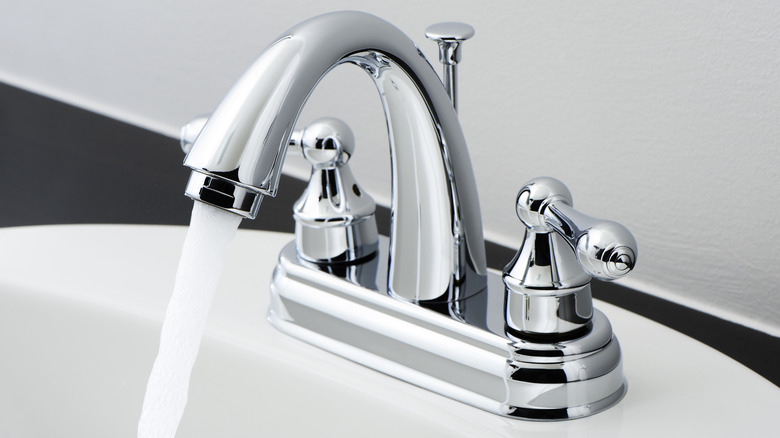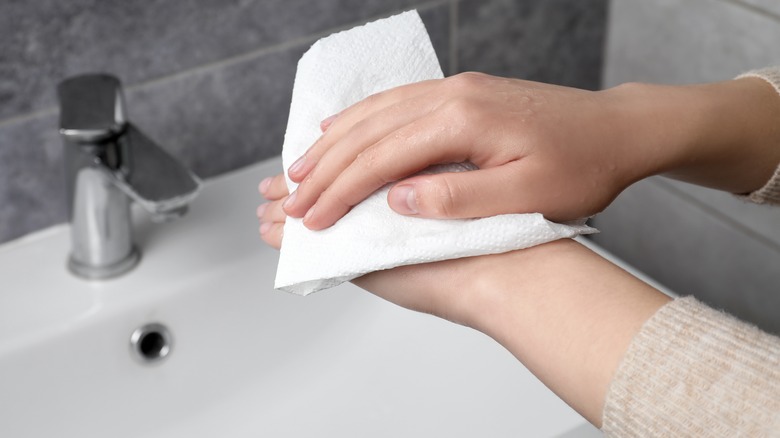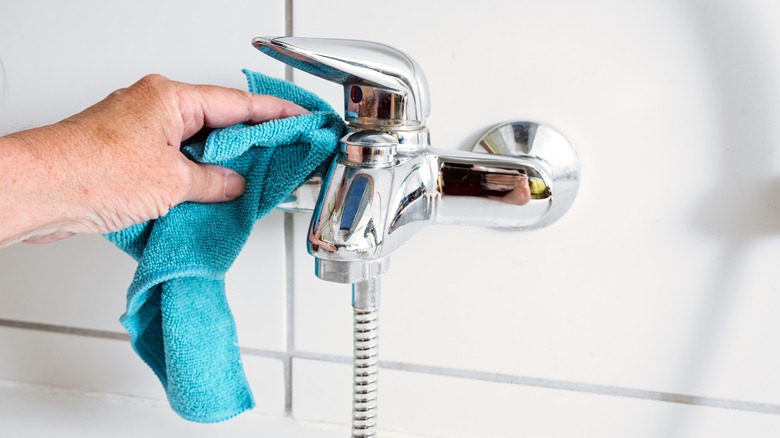Vinegar Soaked Paper Towels Are The Solution To Sparkling Clean Chrome Fixtures
Chrome home decor is always coming in and out of fashion, and fixtures are still one of the most common ways to incorporate chrome into your space. Chrome's extra-shiny finish is part of what makes it so popular, and one way to get sparkling clean chrome fixtures is to soak paper towels in vinegar and wrap them around the fixtures before rinsing and drying.
Chrome is a soft, delicate metal that's almost always plated over a base metal such as nickel, steel, brass, or copper to help add durability and prevent tarnishing. Its shine means that it's easy to clean, but it's important to do so frequently since it shows water spots easily and may accumulate soap scum, dulling the finish. Wiping your chrome fixtures daily helps prevent these issues. But deep cleaning chrome hardware on a regular basis can also help remove any stains or buildup. Here's how to use vinegar to do it.
How to use vinegar on chrome and why it works
Vinegar is effective at restoring shine to dull chrome fixtures because it's mildly acidic, which helps it cut through mineral deposits and remove rust. Either white vinegar or apple cider vinegar will work. There are two ways to use vinegar to clean chrome: one for tougher spots or stains, and one for regular cleaning.
For the former, the paper towel method does the trick. Soak a few paper towels in vinegar. Wrap them around the chrome fixture and let it sit for a while — some say up to one hour. Then unwrap the paper towels, wiping the loosened buildup away. For the latter, dilute the vinegar by mixing one part vinegar with one part water. Spray the solution on the chrome fixtures and gently scrub. You can use a toothbrush for hard-to-reach nooks and crannies.
With both of these methods, it's important to rinse the fixtures with warm water afterward or wipe them with a dampened towel if that's easier. This ensures that no vinegar is left sitting on the chrome. Lastly, immediately dry the fixtures with a soft microfiber cloth to prevent water spots.
Precautions to take with vinegar and chrome
Between chrome's softness and vinegar's acidity, you can cause damage to your fixtures if you're not careful. With prolonged exposure, the vinegar could eat through the chrome plating, causing dulling or even permanently damaging the finish. To prevent this, do not soak the fixtures or let the vinegar sit for too long, and don't neglect to rinse with water afterward.
Undiluted vinegar poses the greatest risk, so you can always stick to diluting your vinegar with water to be safe. Alternatively, you could test undiluted vinegar on a small inconspicuous area first before using it on the entire fixture. If you need to go another route, regular dish soap with warm water is typically a safe bet for chrome.
Additionally, chrome is prone to scratches and discoloration, so it's important to avoid abrasive sponges or scouring pads to prevent damage. Stick to soft cloths, brushes, and sponges instead.


